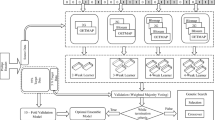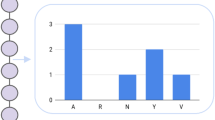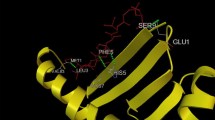Abstract
In this paper, we study the performance improvement that it is possible to obtain combining classifiers based on different notions (each trained using a different physicochemical property of amino-acids). This multi-classifier has been tested in three problems: HIV-protease; recognition of T-cell epitopes; predictive vaccinology. We propose a multi-classifier that combines a classifier that approaches the problem as a two-class pattern recognition problem and a method based on a one-class classifier. Several classifiers combined with the “sum rule” enables us to obtain an improvement performance over the best results previously published in the literature.





Similar content being viewed by others
Notes
With Gamma (parameter of the radial based kernel) = 0.25 and C (Cost of the constrain violation) = 1.5.
Implemented as PRTools 3.17 Matlab Toolbox.
References
Altıncay H, Demirekler M (2000) An information theoretic framework for weight estimation in the combination of probabilistic classifiers for speaker identification. Speech Commun 30(4):255–272
Altıncay H (2006) Ensembling evidential k-nearest neighbor classifiers through multi-modal perturbation. Appl Soft Comput (in press)
Breiman L (1996) Bagging predictors. Mach Learn 24:123–140
Brusic V et al (2002) Prediction of promiscuous peptides that bind HLA class I molecules. Immunol Cell Biol 80:280–285
Bozic I, Zhang GL, Brusic V (2005) Predictive vaccinology: optimization of predictions using support vector machine classifiers, IDEAL 2005, pp 375–381
Cristianini N, Shawe-Taylor J (2000) An introduction to support vector machines and other kernel-based learning methods. Cambridge University Press, Cambridge
Duda R, Hart P, Stork D (2001) Pattern classification. Wiley, New York
Franco A, Lumini A, Maio D, Nanni L (2006) An enhanced subspace method for face recognition. Pattern Recognit Lett 27(1):76–84
Guo J, Lin Y, Sun Z (2005) A novel method for protein subcellular localization: combining residue-couple model and SVM. In: Proceedings of 3rd Asia-Pacific Bioinformatics conference, Singapore, pp 117–129
Ho TK (1998) The random subspace method for constructing decision forests. IEEE Trans Pattern Anal Mach Intell 20(8):832–844
Huang L, Dai Y (2005) A support vector machine approach for prediction of T cell epitopes. In: Proceedings of the third Asia–Pacific Bioinformatics conference (APBC2005), Singapore, pp 312–328
Jain A, Nandakumar K, Ross A (2005) Score normalization in multimodal biometric systems. Pattern Recognit 38(12):2270–2285
Kawashima S, Kanehisa M (2000) A index: amino acid index database. Nucleic Acids Res 28:374
Kuncheva LI, Whitaker CJ (2003) Measures of diversity in classifier ensembles and their relationship with the ensemble accuracy. Mach Learn 51:181–207
Kittler J (1998) On combining classifiers. IEEE Trans Pattern Anal Mach Intell 20(3):226–239
Kittler J, Hatef M, Duin R, Matas J (1998) On combining classifiers. IEEE Trans Pattern Anal Mach Intell 20(3):226–239
Lumini A, Nanni L (2006a) Machine learning for HIV-1 protease cleavage site prediction. Pattern Recognit Lett, available online 2 May 2006
Lumini A, Nanni L (2006b) MppS: an ensemble of support vector machine based on multiple physicochemical properties of amino-acids. NeuroComput 69(13–15):1688–1690
Melville P, Mooney RJ (2003) Constructing diverse classifier ensembles using artificial training examples. In: Proceedings of the IJCAI, pp 505–510
Nakai K, Kidera A, Kanehisa M (1988) Cluster analysis of amino acid indices for prediction of protein structure and function. Protein Eng 2:93–100
Nanni L (2006a) Experimental comparison of one-class classifiers for on-line signature verification. Neurocomputing 69(7–9):869–873
Nanni L (2006b) Comparison among feature extraction methods for HIV-1 protease cleavage site prediction. Pattern Recognit 39(4):711–713
Nanni L (2006c) Machine learning algorithms for T-cell epitopes prediction. Neurocomputing 69(7–9):866–868
Nanni L, Lumini A (2005) Ensemble of Parzen Window Classifiers for on-line signature verification. NeuroComput 68(6):217–224
Nanni L, Lumini A (2006a) A reliable method for HIV-1 protease cleavage site prediction. Neurocomputing 69(7–9):838–841
Nanni L, Lumini A (2006b) An ensemble of K-local hyperplanes for predicting protein–protein interactions, Bioinformatics (22) (10):1207–1210
Nanni L, Lumini A (2007) Region Boost Learning for 2D + 3D based Face Recognition. Pattern Recognit Lett (in press)
Oja E (1983) Subspace methods of pattern recognition. Research Studies Press Ltd, Letchworth
Opitz D, Maclin R (1999) Popular ensemble methods: an empirical study. JArtif Intell Res 11:169–198
Pudil P, Novovicova J, Kittler J (1994) Floating search methods in feature selection. Pattern Recognit Lett 15(11):1119–1125
Rögnvaldsson T, You L (2003) Why neural networks should not be used for HIV-1 protease cleavage site prediction. Bioinformatics 1702–1709
Ruan J, Wang K, Yang J, Kurgan LA, Cios K (2005) Highly accurate and consistent method for prediction of elix and strand content from primary protein sequences. Artif Intell Med, online version 2005
Schapire RE (2002) The boosting approach to machine learning: an overview. In: MSRI workshop on nonlinear estimation and classification, Berkeley
Tax DMJ (2001) One-class classification; concept-learning in the absence of counter-examples, Delft University of Technology, June 2001, ISBN: 90-75691-05-x
Tomii K, Kanehisa M (1996) Analysis of amino acid indices and mutation matrices for sequence comparison and structure prediction of proteins. Protein Eng 9:27–36
Whitaker CJ, Kuncheva LI (2003) Examining the relationship between majority vote accuracy and diversity in bagging and boosting, Technical Report, School of Informatics, University of Wales, Bangor
Zenobi G, Cunningham P (2001) Using diversity in preparing ensembles of classifiers based on different feature subsets to minimize generalization error, In: Raedt LD, Flach PA (eds) Proceedings of the 12th conference on machine learning, Lecture Notes in Computer Science 2167, pp 576–587
Zhang GL et al (2005) Neural models for predicting viral vaccine targets. J Bioinform Comput Biol 3:1207–1225
Zhao Y, Pinilla C, Valmori D, Roland Martin R, Simon R (2003) Application of support vector machines for T-cell epitopes prediction. Bioinformatics, 19(15):1978–1984
Zhou Z,Yu Y (2005) Ensembling local learners through multimodal perturbation. IEEE Trans Syst Man Cyber B Cyber 35(4):725–735
Acknowledgments
The author would like to thank Ivana Bozic, T. Rögnvaldsson and Y. Zhao for sharing the datasets.
Author information
Authors and Affiliations
Corresponding author
Rights and permissions
About this article
Cite this article
Nanni, L., Lumini, A. Machine learning multi-classifiers for peptide classification. Neural Comput & Applic 18, 185–192 (2009). https://doi.org/10.1007/s00521-007-0170-2
Received:
Accepted:
Published:
Issue Date:
DOI: https://doi.org/10.1007/s00521-007-0170-2




